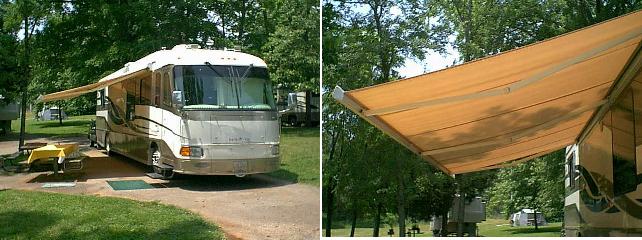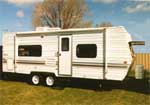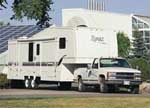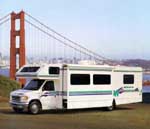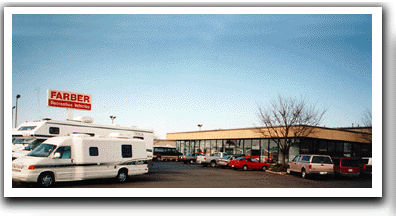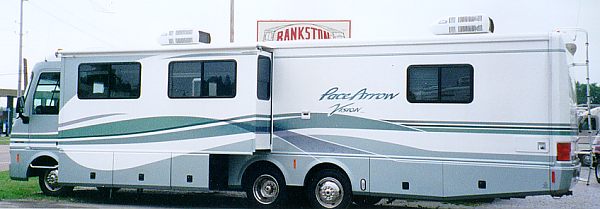Chapter 1 - RV Basics
If you're like I was before buying my first motorhome, you don't even know that RV stands for Recreational Vehicle. I learned a little while I was buying my first genuine RV and alot more since. In this chapter, I give a few definitions of different types of RVs, tell you what kind I bought and why, and list a few things I've learned relative to Options when buying an RV and Tips while using one.
Before we start, let me say that my opinions are somewhat biased as are most RV owners. It seems that whatever type of RV a person owns is unquestionably, in their opinion, the best type to buy. If you want some unbiased opinions, let me suggest the "Wish You Were Here" show on the Nashville Cable Network (assuming they don't take it off the air). If you can get this show, they give you very straight-forward advice on buying and tell the pros and cons of travel trailers, motorhomes, and other camping units. Sorry about that -- as good as the show was, they took it off the air. Charles Kuralt had a similar show for awhile also, but now he's gone too. I guess it's time for me to call a network and volunteer to do a show ... lol. If anyone knows of a similar show on the Travel Channel or whatever, send me email.
You're Visitor #
 | ||||||
Nothing in this site is copyrighted -- I'd be honored if you'd reuse anything you find here for your website
My First Book
Retire and Travel For $1000 a Month

- Class B Motorhome: Much like a Class C, except that they are molded into one piece to lose the "pickup truck" look and they are slightly more expensive. This Class B picture (with Class C behind it) is courtesy of Farber East RV Superstore in Columbus, Ohio. Click the Farber sign to visit their website.
- Fifth Wheels: Slightly more expensive than a comparably-sized travel trailer, these have the
advantage of also being slightly more stable than travel trailers. These are the trailers that have
a large hitch that sits right in the middle of the bed of a pickup truck. If I was going to get a
trailer-type RV, I think this is the kind I would buy since I never have been very trusting of a
little 1"-2" ball hitch.
- Camper Vans: This is the first step into what are referred to as motorhomes -- one-piece
motorized vehicles with the comforts of home. Their price range is about comparable to a fifth
wheel, but you get alot less space for your dollar. Of course, you don't have to buy the pickup
truck, so I guess the cost may actually be less with a van.
- Class C Motorhome: This is the kind of motorhome that looks like a camper shell on the back
of a pickup but, when you look inside, you discover that it's all one piece. If you can get out of
the driver's seat and walk into the back without going outside, then it's a Class C motorhome. I
don't really understand why anyone buys a Class C, since you can generally get a Class A for
about the same price.
- Travel Trailers: These vary from the foldout kind that look like a
tent on wheels for a couple thousand dollars to those that look
like a mobile home and run ten thousand and up. If your budget is
limited, these are the kind for you -- you can get alot of space for
a relatively small amount of money.
First off, let's just define the different types of RVs:
All of the pictures here (except the Class B) are provided courtesy of OregonRVs.com. If you'd
like to see OregonRVs' complete descriptions of these various types of RVs, click any picture.
- Camper Shells: These are the cheapest type of RV, where you buy a camper shell for a few
hundred to a couple of thousand dollars and put it on the back of your pickup truck.
Why do I prefer a Class A? Well, first off, they look alot more prestigious and impressive -- if I'm going to spend that much money, I would hope to impress people. Also, I noticed early on that when you're in the driver's seat of a Class A, you have a much better perception of the heighth and width of the vehicle. In a Class C, there is about 3 feet of motorhome above the top edge of the windshield -- very deceiving to a driver who is new at driving motorhomes and is not accustomed to worrying about overhangs being too low, etc. Likewise, the cab of a Class C is several feet narrower than the home part of the vehicle. In a Class A, you look out of the windshield and have a pretty fair idea of exactly where the top and sides of your vehicle are.
Another question I've been asked is why a 23' was ok then, but I'm looking for a bigger one now? Well, we plan to live in this one for a long time and the larger ones do have a few more luxuries. In the 23', the only places to sit were at the dinette table or in the driver/passenger seats up front. The larger ones offer a sofa and chair between the table and the front seats. Also, I like the bath with a door that closes -- the 23' had an open bathroom with only a curtain to close. Finally, I feel that the 23' was fine as a first motorhome, but since then we have learned more about them and the options that we know we would like to have for the long term.
I have some fairly strong opinions about options I like and those I don't like, so (take them or leave them) here are those opinions: [Unbelievable as it may seem to those who know me, my opinions have changed somewhat on some of these based upon further camping experience and changing situations -- these changes are in red in the following sections]
- Spotlight: Must have one. The first time you get caught out in the country looking for a place to park after dark, being able to see what's off the side of the road may be a lifesaver. [An alternative I've found as I've gotten a little older is to just not drive after dark -- then you can do without the spotlight]
- Dash Air-Conditioning: Better buy it if you plan to sell the motorhome someday. When I bought the motorhome in Alabama, I didn't see any reason to buy dash air when I had roof air. When I decided to sell it on the West Coast, I found out that almost all motorhomes out there have dash air. Many buyers shied away simply because I didn't have dash air. I was finally able to sell it buy convincing the buyer that it was ok since both roof and dash air consume about 1 gallon of fuel per hour at 45 mph. The dash air also depletes your engine's power, so why not just stay with roof air? [This may be a moot point, since I think almost all motorhomes today have dash air as standard. If you go to buy one older than about 1987, it may be worth checking]
- Dash Fans: Highly recommended. When you're only getting eight miles to a gallon, you'd really rather not cut it to seven by turning on air conditioning. Dash fans can do alot to cool the front seats when it's not exceptionally hot.
- Awning: Must have one. Park out in the 112-degree sunlight in Nevada for a few days, then ask me why you need an awning. [2003 update: I've noticed the last few years that I seldom use my awning -- probably because I don't spend that much time sitting around under it. I park the RV, go off and do whatever, and mainly use the RV as a place to eat and sleep. Awnings are probably still a great idea, however, as they significantly enhance the resale for those buyers who think they must have one.]
[2004 update: Recently, I've noted some on top-of-the-line motor homes that had no supports to bump into and that work with a remote like a TV control. Below is a picture of one of these very nice, but probably also very expensive, contraptions.]
- Class A Motorhome: This is the big square-looking vehicle like on the front cover of this book. In my opinion, this is the only way to go if you can figure out a way to afford it. When I went out to buy my first RV, I was looking for a Class C since I figured that they were cheaper. The second dealer I went to was an Allegro dealer -- Allegro builds Class A, B, and C motorhomes in Red Bay, Alabama. The Allegro salesman showed me a couple of Class Cs, until I found one I rather liked for about $25000. At this point, he told me I could get a Class A the same size for the same price. I was overwhelmed! I had never dreamed that I could afford one of the beautiful Class A homes. He walked me through a 23' Class A and I was walking on clouds. I bought it and was never disappointed in its performance, comfort, or features.
The dealer I'm writing about here is Bankston Motor Homes in Huntsville, Alabama. The 23' Allegro I purchased was much like the one on the front page of this book. Since then, I sold the Allegro and then bought a 31' Bounder -- also from Bankston. The picture below shows one of the many luxury vehicles that can now be purchased if you've got $100,000 or so to spend. Click the picture to go read more about Bankston and his inventory.
Notice that the Class A motorhome below has what's called a slideout. When I originally wrote this book, only trailers had slideouts. Now they can be obtained on both Class C and Class A motorhomes. Although the minimum length motorhome with slideout changes just about every year, as of 2004 they're putting them on 23' Class As and Cs. The slideout adds width to the interior, which is of great importance to some people. Current Class As may have up to 4 slideouts (e.g., two for living area, one for kitchen, and one for bedroom) and 5th wheels can have up to 5. There are also differences in the slideouts offered with various motorhomes, as shown in the pictures below. CLICK HERE to read an entire page dedicated to slideout details.
- Aluminum versus Fiberglass Body: Hard to call. Aluminum is bad in a hailstorm -- you may end up with thousands of dents. I understand that fiberglass may "delaminate" over time -- i.e., top layers peel off. West Coast buyers have never seen anything but fiberglass, so aluminum is hard to sell out there. I guess my tendency would be to go for the fiberglass.
- Bench Seat Dinette versus L-Shaped: I much prefer the bench seat, where those seated are facing one another. Very good for playing card games, etc. with your traveling companion(s), which is how you spend alot of your evenings on the road.
- Over-Cab Bed: Forget it unless you have a small child and have nowhere else to put him/her. The bed that you can pull down over the cab in some Class A motorhomes is too tight for anyone other than a small child. Even then, if they forget and sit up in bed, they bump their head on the roof. My three-year-old grandson slept up there one night, bumped his head about 5-10 times, and probably would not agree to sleep there again. Another disadvantage that we found with this over-cab bed is that it had a tendency to squeak alot when we got on bumpy roads.
- Basements: This is a fantastic option that has only been available since about 1987. Most Class A manufacturers now offer this option of raising the floor and the roof about a foot to leave more storage space under the floor. I think this is a great idea for full-timers, since I'm not too keen on roof luggage carriers.
- Roof Luggage Carriers: As I said above, I'm not too keen on these. If I have anything on my roof, I continuously worry about it falling off, getting wet, or coming open. I also feel that these roof-top containers are more liable to get broken into by thieves, who are probably not familiar enough with motorhomes to know that stuff is stored in the "basement".
- Power Levelers: These generally cost two to three thousand dollars extra, but are very worthwhile if you can afford them. I didn't have any on my 23' home and consequently spent alot of time driving around a parking area trying to the vehicle level. With the levelers, you park where you want to and then use the levelers to level the vehicle. See the "tips" section which follows to learn why leveling is important. [Don't know why I didn't mention it here, but many people just carry some wood with them (like 2x6's) and run the wheels up on these until they're level -- also can buy more elaborate hardware to stick under the wheels at Camping World and other stores. Of course, automatic levelers are still better if you can afford them.]
- Power Steps: I'm leery of them because I suspect that, like power windows on cars, they tend to quit working when the vehicle gets older. On the other hand, they help ensure that you don't forget to put the steps up before you start traveling (as I did a few times). [2003 update: After 20 years of RVing and having two motorhomes with power steps and never having seen them fail, I guess I'd recommend in favor. Most modern motorhomes have them standard, so maybe it's not worth discussing.]
- Satellite Dish: These are the small television satellite antennae that fit on top of your motorhome. I've had no experience with these, but they seem like a great idea if you can afford one. The people I've seen who have them seem to use them every time they park. I know that the small antenna that came on the Allegro was only powerful enough to pull in channels within 10-15 miles. Anytime we were camped out in the wilds, we had no television. Some spouses might well see this as an advantage, not a problem ... lol. [2003 update: Dishes have gotten cheaper and more efficient, so more and more people have them. The kind on top of the RV are easier, but can get blocked if you park under trees or whatever. Most people seem to be opting for the type that sit on the ground near the RV.]
- Towing a Vehicle: We got along fine in our 23' without towing a car behind. We found that the motorhome would go almost anywhere you could take a car -- we even parallel-parked it in downtown Dallas once (in two parking spaces). One disadvantage was that alot of gasoline was probably unnecessarily burned going around towns sight-seeing. This was probably somewhat balanced, however, by the amount of fuel saved by not towing the car. I would guess that, for a home larger than 23', towing a car would be highly desirable. We plan to pull one behind our 31'. [While we had the 31' Bounder, we tried it both ways -- with and without a tow vehicle. Found that we ended up doing alot of walking, even just getting around the campground. Also tried carrying bicycles for awhile -- I guess I'd tend toward towing a vehicle if feasible. That then brings up the topic of How to Tow. The only type I've used is the tow dolly, where the two drive wheels are up on the dolly and the other two are on the ground -- it was ok, but required a little wriggling around under the front bumper to hook and unhook it. I suppose the best way to go here is a collapsible tow-bar, if you can get a car that'll tow with all 4 wheels on the ground. Some automatics allow that (like Saturn and Geo), but stick shift is obviously the best. There are also several ways of disengaging the transmission to tow, but these always sounded a bit too complicated for me. I'll modify this if I get alot of email arguing that I'm wrong about this. I've also seen trailers that you drive your car completely onto, but here you're talking about a significant investment in trailer, larger motorhome, and fuel -- probably not to your taste if you're reading this book.]
Now, how about some tips about operating a motorhome? These are some things I learned through experience that I would rather have read somewhere before I started:
- Make sure you're level if you park for more than 30 minutes or so. It turns out that some of your systems won't work well if the vehicle isn't level. Some, like your refrigerator, may even need expensive repairs if operated in a non-level position for any significant length of time. [When I had the Allegro, I was told that if I was within 3 degrees of level, all was ok. After a time, I began to get very lax about this. Was in Florida in the Bounder once and thought I was fairly level -- when I opened the freezer about the second day, I was greeted by the smell of ammonia. Talking with a few veterans around the park convinced me that I was going to have to replace the refrigerator. Got a price of $900 from several sources, then managed to get a $500 price from my old friend Bankston in Huntsville. Went without a refrigerator for a few days until getting back to Huntsville to get it fixed. Was much more careful about leveling after that. When I bought my current RV (a 1998), I was told the new refrigerators aren't near as sensitive. I'm still careful!]
- Know exactly the heighth and width of your vehicle. I was surprised to find that, in some places out West, there are tunnels that are too small for some motorhomes. Upon entering Yellowstone Park, I encountered a sign that showed three routes into the park -- one we couldn't fit through, one that we fit with only inches to spare, and one that left plenty of room. We took the "inches to spare" one -- next time we'll go with the "plenty of room" option. It was really, really tight.
- Before you start your engine to move out, be sure to check to see that the refrigerator is locked and the steps are folded up. We forgot the refrigerator several times, the most memorable being on the curvy, hilly road going up to Boulder Dam -- I especially remember the eggs, milk, and broken pickle jar that were so difficult to clean up afterwards. Forgetting the steps is not too bad, since you very soon can hear them scraping on the curb or roadbed. The problem comes when you can finally figure out what the strange noise is, get stopped again, and try to straighten them back to something that resembles their original shape. [You may be able to ignore these warning altogether if you buy one of the newer motorhomes -- most modern ones have automatic steps and refrigerators that click-lock every time you close them]
- Never look around behind your while driving. When you're driving a car, you can quickly glance around in the back seat to see what's going on without getting into too much trouble. A motorhome is much different -- you must keep your eyes on the road at all time. Due to the size of the motorhome, taking your eyes off the road for a few seconds can put you either on the wrong side of the road or in the ditch. I learned this lesson very early -- thankfully when the road was relatively empty. I learned it so well that when the refrigerator fell open at Boulder Dam I merely asked calmly what that crash was -- didn't turn around or even glance back through the inside rear-view mirror.
- Avoid using your cruise control while going uphill. When we got to Devil's Tower, Wyoming, we lost first and reverse from our transmission. I at first blamed this mishap on the Tower, but was later told by a mechanic that using the cruise control continuously while going up and down hills was hard on the transmission. I had thought it was neat the way it automatically shifted gears to go up hills -- didn't do that anymore after that. Just lucky the drive-train was still under warranty.
- Avoid small parking lots if your reverse gear is gone. We learned this in connection with the Devil's Tower experience. We had driven to a town to look for a mechanic and I pulled into a shopping center parking lot. Unfortunately, I got myself into a position where I couldn't go forward and had to get a backwards tow from a pickup truck -- very embarrassing for a prestigious and impressive motorhome ... lol.
- Use the rearview mirror to stay in your lane. When I first started driving the motorhome, the salesman gave me this valuable tip. Just as when you started driving a car, it's difficult to get the motorhome precisely aligned in the middle of your lane. To see where you are, look into the rearview mirror on the driver's side. You will be able to see the side of the motorhome and the white line, so you can easily see where you are in the lane. After awhile, of course, you get more practiced and can stay in your lane without using this trick. Every now and then, however, like when you're going through a very narrow tunnel, this trick will again come in handy.
- Air gets in the fuel tank at high altitudes. So what, you say -- well, we had a real scare one day after climbing several miles in the Rockies because we didn't know about air in the tanks. After we parked, we began hearing loud booming sounds coming from the fuel tanks. It stopped after several minutes, but until it did we were quite concerned. A mechanic later told us that going to high altitudes can cause air to build up in a fuel tank. Since the motorhome tank is larger than most, the sounds made by the air are much more pronounced than in a car.
- Engines often vaporlock (i.e., quit) at high altitudes. We were traveling through Bryce National Park when the engine suddenly stopped dead. After trying to restart it for a few minutes, I walked about three miles to a phone to call a wrecker. When the wrecker arrived about 30 minutes later, the motorhome started fine. The mechanic charged us $20 and told us this was vaporlock. The motor just sort of overheats and all you can do is wait for it to cool off again.
Two final tips on operating a motorhome:
- Pack some spare water. When we first started out, someone told us to pack spare water for emergencies. We had some plastic two-liter soft drink bottles, so we filled them up and put them in one of the motorhome's storage compartments. We only used them once or twice as canteens when we went hiking, never having an emergency that required them, but we felt safer knowing they were there.
- Don't park overnight in the roadside park by the Rio Grande Gorge Bridge north of Taos, New Mexico. This was the most frightening experience of our entire trip. We stopped in this picturesque park with a fantastic view of the Gorge and settled in for the night. After awhile, a wind started to blow with gusts up to 70 mph (according to the radio the next day). The land was very flat, so the wind had nothing to slow it down and we had nothing to hide behind. After sitting frozen in the swaying motorhome for about an hour not saying a word, we were relieved to finally hear the wind subsidin. We both had felt like if we moved the motorhome might roll over into the 600' deep gorge. We later agreed that this was one of the most frightening experiences we ever hoped to go through.
Wait! Don't start here! If you haven't read the introduction, click here and first go find out what this book is all about.
